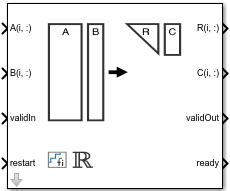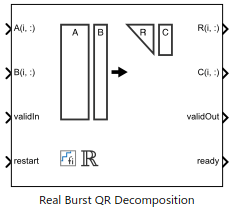Real Burst QR Decomposition
QR decomposition for real-valued matrices

Libraries:
Fixed-Point Designer HDL Support /
Matrices and Linear Algebra /
Matrix Factorizations
Description
The Real Burst QR Decomposition block uses QR decomposition to compute R and C = Q'B, where QR = A, and A and B are real-valued matrices. The least-squares solution to Ax = B is x = R\C. R is an upper triangular matrix and Q is an orthogonal matrix. To compute C = Q', set B to be the identity matrix.
When Regularization parameter is nonzero, the
Real Burst QR Decomposition block transforms in-place to and in-place to where λ is the regularization parameter, QR is the
economy size QR decomposition of , A is an m-by-n
matrix, p is the number of columns in B,
In =
eye(n), and
0n,p =
zeros(n,p).
Examples
Implement Hardware-Efficient Real Burst QR Decomposition
How to use the Real Burst QR Decomposition block.
Determine Fixed-Point Types for QR Decomposition
Use fixed.qrFixedpointTypes to determine fixed-point types for
computation of QR decomposition.
Ports
Input
Rows of real matrix A, specified as a vector. A is an m-by-n matrix where m ≥ 2 and n ≥ 2. If B is single or double, A must be the same data type as B. If A is a fixed-point data type, A must be signed, use binary-point scaling, and have the same word length as B. Slope-bias representation is not supported for fixed-point data types.
Data Types: single | double | fixed point
Rows of real matrix B, specified as a vector. B is an m-by-p matrix where m ≥ 2. If A is single or double, B must be the same data type as A. If B is a fixed-point data type, B must be signed, use binary-point scaling, and have the same word length as A. Slope-bias representation is not supported for fixed-point data types.
Data Types: single | double | fixed point
Whether inputs are valid, specified as a Boolean scalar. This control signal
indicates when the data from the A(i,:) and
B(i,:) input ports are valid. When this value is 1
(true) and the value at ready is 1
(true), the block captures the values on the
A(i,:) and B(i,:) input ports. When this
value is 0 (false), the block ignores the input samples.
After sending a true
validIn signal, there may be some delay before
ready is set to false. To ensure all data is
processed, you must wait until ready is set to
false before sending another true
validIn signal.
Data Types: Boolean
Whether to clear internal states, specified as a Boolean scalar. When this value
is 1 (true), the block stops the current calculation and clears all
internal states. When this value is 0 (false) and the
validIn value is 1 (true), the block begins
a new subframe.
Data Types: Boolean
Output
Rows of the economy size QR decomposition matrix R, returned as a scalar or vector. R is an upper triangular matrix. The size of the matrix R is min(m,n)-by-n. R has the same data type as A.
Data Types: single | double | fixed point
Rows of the economy size QR decomposition matrix C=Q'B, returned as a scalar or vector. C has the same number of rows as R. C has the same data type as B.
Data Types: single | double | fixed point
Whether output data is valid, returned as a Boolean scalar. This control signal
indicates when the data at output ports R(i,:) and
C(i,:) is valid. When this value is 1
(true), the block has successfully computed the
R and C matrices. When this value is 0
(false), the output data is not valid.
Data Types: Boolean
Whether block is ready, returned as a Boolean scalar. This control signal that
indicates when the block is ready for new input data. When this value is 1
(true) and the validIn value is 1
(true), the block accepts input data in the next time step. When
this value is 0 (false), the block ignores input data in the next
time step.
After sending a true
validIn signal, there may be some delay before
ready is set to false. To ensure all data is
processed, you must wait until ready is set to
false before sending another true
validIn signal.
Data Types: Boolean
Parameters
Number of rows in input matrices A and B, specified as a positive integer-valued scalar.
Programmatic Use
Block Parameter:
m |
| Type: character vector |
| Values: positive integer-valued scalar |
Default:
4 |
Number of columns in input matrix A, specified as a positive integer-valued scalar.
Programmatic Use
Block Parameter:
n |
| Type: character vector |
| Values: positive integer-valued scalar |
Default:
4 |
Number of columns in input matrix B, specified as a positive integer-valued scalar.
Programmatic Use
Block Parameter:
p |
| Type: character vector |
| Values: positive integer-valued scalar |
Default:
1 |
Regularization parameter, specified as a nonnegative scalar. Small, positive values of the regularization parameter can improve the conditioning of the problem and reduce the variance of the estimates. While biased, the reduced variance of the estimate often results in a smaller mean squared error when compared to least-squares estimates.
Programmatic Use
Block Parameter:
regularizationParameter |
| Type: character vector |
| Values: real nonnegative scalar |
Default:
0 |
Tips
Use fixed.getQRDecompositionModel(A,B) to generate a template model
containing a Real Burst QR Decomposition block for real-valued input matrices
A and B.
Algorithms
Systolic implementations prioritize speed of computations over space constraints, while burst implementations prioritize space constraints at the expense of speed of the operations. The following table illustrates the tradeoffs between the implementations available for matrix decompositions and solving systems of linear equations.
| Implementation | Throughput | Latency | Area |
|---|---|---|---|
| Systolic | C | O(n) | O(mn2) |
| Partial-Systolic | C | O(m) | O(n2) |
| Partial-Systolic with Forgetting Factor | C | O(n) | O(n2) |
| Burst | O(n) | O(mn) | O(n) |
Where C is a constant proportional to the word length of the data, m is the number of rows in matrix A, and n is the number of columns in matrix A.
For additional considerations in selecting a block for your application, see Choose a Block for HDL-Optimized Fixed-Point Matrix Operations.
This block uses the AMBA AXI handshake protocol [1]. The valid/ready handshake process is used to transfer data and control information. This two-way control mechanism allows both the manager and subordinate to control the rate at which information moves between manager and subordinate. A valid signal indicates when data is available. The ready signal indicates that the block can accept the data. Transfer of data occurs only when both the valid and ready signals are high.
The Burst QR Decomposition blocks accept and process A and B matrices row by row synchronously. After accepting m rows, the block outputs the R and C matrices row by row continuously. The matrices are output from the last row to the first row.
For example, assume that the input A and B matrices
are 3-by-3. Additionally assume that validIn asserts before
ready, meaning that the upstream data source is faster than the QR
decomposition.

In the figure,
A1r1is the first row of the first A matrix,R1r3is the third row of the first R matrix, and so on.validIntoready— From a successful row input to the block being ready to accept the next row.Last row
validIntovalidOut— From the last row input to the block starting to output the solution.validOuttoready— From the block starting to output the solution to the block ready to accept the next matrix input.
The following table provides details of the timing for the Burst QR Decomposition blocks.
| Block | validIn to ready (cycles) | Last Row validIn to validOut
(cycles) | validOut to ready (cycles) |
|---|---|---|---|
| Real Burst QR Decomposition | (wl + 5)*min(m,n) + 2 | (wl + 5)*min(m,n) + 2 | min(m,n) + 1 |
| Complex Burst QR Decomposition | (wl*2 + 11)*min(m,n) + 2 | (wl*2 + 11)*min(m,n) + 2 | min(m,n) + 1 |
In the table, m represents the number of rows in matrix A, and n is the number of columns in matrix A. wl represents the word length of the input data.
If the data type of A is double, then wl is 53.
If the data type of A is single, then wl is 24.
If the data types of A and B are fixed point, then wl is given by
max(A.WordLength + ~issigned(A), B.WordLength + ~issigned(B))
This block supports HDL code generation using the Simulink® HDL Workflow Advisor. For an example, see HDL Code Generation and FPGA Synthesis from Simulink Model (HDL Coder) and Implement Digital Downconverter for FPGA (DSP HDL Toolbox).
This example data was generated by synthesizing the block on a Xilinx® Zynq® UltraScale™ + RFSoC ZCU111 evaluation board. The synthesis tool was Vivado® v.2020.2 (win64).
The following parameters were used for synthesis.
Block parameters:
m = 16n = 16p = 1Matrix A dimension: 16-by-16
Matrix B dimension: 16-by-1
Input data type:
sfix16_En14Target frequency: 300 MHz
The following tables show the post place-and-route resource utilization results and timing summary, respectively.
| Resource | Usage | Available | Utilization (%) |
|---|---|---|---|
| CLB LUTs | 8646 | 425280 | 2.03 |
| CLB Registers | 8797 | 850560 | 1.03 |
| DSPs | 0 | 4272 | 0.00 |
| Block RAM Tile | 0 | 1080 | 0.00 |
| URAM | 0 | 80 | 0.00 |
| Value | |
|---|---|
| Requirement | 3.3333 ns |
| Data Path Delay | 3.104 ns |
| Slack | 0.211 ns |
| Clock Frequency | 320.27 MHz |
References
[1] "AMBA AXI and ACE Protocol Specification Version E." https://developer.arm.com/documentation/ihi0022/e/AMBA-AXI3-and-AXI4-Protocol-Specification/Single-Interface-Requirements/Basic-read-and-write-transactions/Handshake-process
Extended Capabilities
Slope-bias representation is not supported for fixed-point data types.
HDL Coder™ provides additional configuration options that affect HDL implementation and synthesized logic.
This block has one default HDL architecture.
| General | |
|---|---|
| ConstrainedOutputPipeline | Number of registers to place at
the outputs by moving existing delays within your design. Distributed
pipelining does not redistribute these registers. The default is
|
| InputPipeline | Number of input pipeline stages
to insert in the generated code. Distributed pipelining and constrained
output pipelining can move these registers. The default is
|
| OutputPipeline | Number of output pipeline stages
to insert in the generated code. Distributed pipelining and constrained
output pipelining can move these registers. The default is
|
Supports fixed-point data types only.
Version History
Introduced in R2019bThe Real Burst QR Decomposition block now supports the Tikhonov Regularization parameter.
MATLAB Command
You clicked a link that corresponds to this MATLAB command:
Run the command by entering it in the MATLAB Command Window. Web browsers do not support MATLAB commands.
Select a Web Site
Choose a web site to get translated content where available and see local events and offers. Based on your location, we recommend that you select: .
You can also select a web site from the following list
How to Get Best Site Performance
Select the China site (in Chinese or English) for best site performance. Other MathWorks country sites are not optimized for visits from your location.
Americas
- América Latina (Español)
- Canada (English)
- United States (English)
Europe
- Belgium (English)
- Denmark (English)
- Deutschland (Deutsch)
- España (Español)
- Finland (English)
- France (Français)
- Ireland (English)
- Italia (Italiano)
- Luxembourg (English)
- Netherlands (English)
- Norway (English)
- Österreich (Deutsch)
- Portugal (English)
- Sweden (English)
- Switzerland
- United Kingdom (English)

